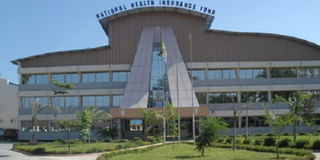CAG report uncovers financial flaws in NHIF to the tune of billions of shillings

What you need to know:
- The report, unveiled in Dodoma on Wednesday April 10, said the reimbursement of funds claimed from NHIF showed irregularities which NHIF must now work on.
Dar es Salaam. The National Health Insurance Fund (NHIF) made “ghost” payments amounting to Sh2.6 billion, the Controller and Auditor General (CAG) report has established.
The report, unveiled on Wednesday, April 10 in Dodoma, says the reimbursement of funds claimed from NHIF showed that sevem regional secretariat offices incurred losses amounting over Sh290 million due to improper filling of claims submitted to NHIF and thus contravening with Sec. 27(2) of NHIF Act, 1999.
“Comparably, I have noted that the losses from rejected claims has decreased from Sh343 million to Sh292 million from financial year 2016/17 to 2017/18 respectively. The entities involved have also slightly decreased from 9 to 7,’’ reads the CAG report.
According to the CAG, the management of the respective regional secretariat and hospitals do not closely supervise and ensure that the claim forms are duly and responsibly filled, warning that this may jeopardise service delivery at the expense of rejected claims.
“As a consequence, improper filling of NHIF claim forms has led to a rejection of claims aggregating to Sh292 million implying that the questioned entities suffered a loss to the tune of the rejected claims,’’ says the CAG.
The CAG also found incorrect prices applied on claims and payment to medical facilities for non-contributing members of NHIF.
However, the CAG identified claims lodged to NHIF which used higher rates than those approved.
“From a sample of four medical facilities, namely, the Muhimbili National Hospital, TMJ Hospital, Report of Public Authorities and other Bodies 2017/2018 15 Regency Hospital Medical Clinic and KCMC, I noted overpayments of Sh141.61 million from the overpriced claims,’’ said the CAG.
Further, the CAG says he identified payments totaling Sh4.80 billion made by NHIF to medical facilities for non-contributing members contrary to the principles of health insurance.
“The above noted anomalies might have occasioned significant financial loss to the Fund given the number of medical facilities working with it. I recommend that the management of NHIF strengthen controls over claims by ensuring automation of claims approval process in the long run and increase sensitivity of the process in the meantime,’’ he said.
Further, the CAG found significant claims from ineligible child dependents. He says there were paid claims amounting to Sh13.99 billion for medical services provided to dependent children who had attained the age of 18.
“This is contrary to the NHIF’s Act which limits the age of a dependent child to below 18 years old. The loss of funds due to such payments implies the reduction of resources available to NHIF for other development activities. I recommend that the NHIF’s management update its database to identify over-aged child dependents and institute controls that will ensure that they are no longer covered by the insurance,’’ said the CAG.
At NHIF, the CAG says, he noted there were a total of 100,032 active NHIF cards that received medical services with claims totaling to Sh3.61 billion while their principal members had not made any contributions.
“I identified 149,939 over-age dependents with claims totaling to Sh14.81 billion; there were 156 cards that were registered more than 20 times usage in a particular month and 132 cards that registered activities in at least two different geographical regions on the same day,” reads part of the report.
“I also identified 682 cards of principal members with more than five active cards of dependents ranging from 7 to 18 dependents; and I identified a total of 181,335 instances of expired cards that are still active and found a total of 1,232 Report of Public Authorities and other Bodies 2017/2018 97 expired cards that were used to receive medical services with claims totaling to Sh 31.06 million,” reads further the report.



